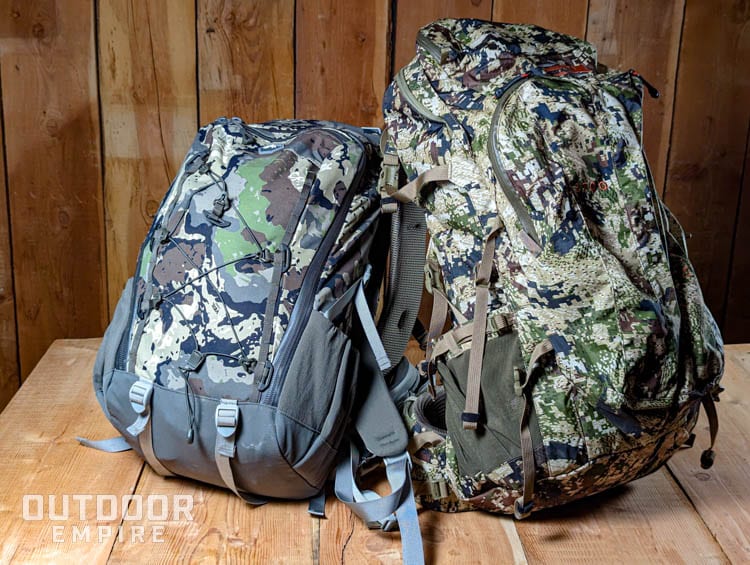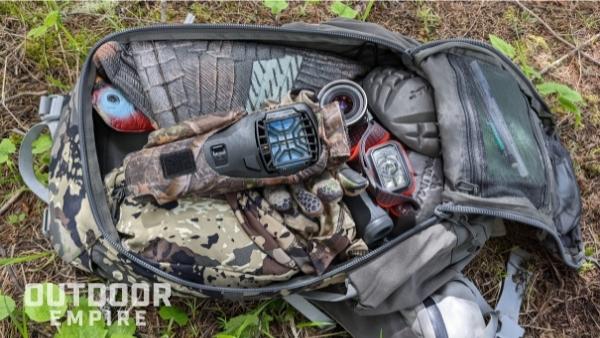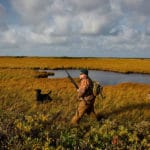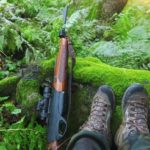Whether it’s a several-hour excursion to your deer stand or a weeklong trip into the backcountry, hunting packs are a vital piece of any serious outdoorsman‘s gear.
One of the most common questions I get from first-time hunters looking to venture out into the outdoors is: what do I need in my backpack?
From first aid and survival gear to extra rounds, snacks, and clothing, hunting packs provide hunters the ability to bring with them contingencies for emergencies and creature comforts out into the field. While there is a lot of gear touted as “essential,” hunters often overpack their bags and carry extra weight into the woods, much of which they will never use.
In this article, we cover the different setups hunters may use for packs and the necessities of what they should fill them with.
Types of Hunting Packs
In my experience, there are three main kinds of packs that hunters universally use:
- Backpack
- Daypack
- Trek pack
A backpack is usually used when a hunter is heading out for no more than a couple of hours into a tree stand or the field. There is usually a vehicle or structure nearby they are staging from.
A daypack is often utilized when hunters will be out in the field for the duration of the day or even staying overnight. This larger pack provides enough room for the essentials a hunter may need for 24 hours out in the field.
A trek pack or ruck is most often used for over 48 hours in the field, though I have seen hunters survive for over two weeks on everything they brought in this pack.

To dig deeper into each pack, let’s look at when and why you might use each configuration, and what you’ll want to pack in each depending on the situation.
What to Pack in a Hunting Backpack
You are headed to your tree stand. You plan to be there for no more than 3 to 4 hours before heading back to camp or the truck. This setup should be lightweight, comfortable, and easy to take on and off.
Regardless of how long or short you anticipate your hunt will be, the essentials to carry in any hunting pack are:
- Extra camo/layers
- Water
- First aid gear
- Rope
Snacks are optional, but bringing food to your deer stand is not recommended as it can scent up the location and alert deer to your presence.
Hunters will often carry doe estrus and small bags of grain or corn in their bags to bait the trail in or the field they plan on hunting. That, however, depends a lot on where your hunting and whether it’s legal in your area.
Check out our best hunting backpacks guide.
What to Pack for a Full Day Hunt
So you’re headed out to the field and won’t come back till nightfall, maybe you are even camping under the stars. A day pack is designed to carry everything you need to last 24 hours on a lightweight frame.
This pack has two requirements:
- It should be comfortable enough that you can shoulder it all day without chafing or back pain.
- It must fit all the necessities you need in the field while still having room to pack out your trophy kill.
With these packs, I often see hunters carrying:
- food and water
- extra camouflage/layers
- extra ammunition
- survival gear (emergency use), see below
- first aid gear
- spotting scope/rangefinder/binoculars
- flashlight
- skinning knife
- toilet paper
- camping gear
- rope
- firestarter
Additional items I often see carried include a change of socks, digging or cutting tools, and riggers or duct tape for if a piece of equipment fails.
Check out our Pnuma Chisos Backpack Review.
What to Pack for Long or Overnight Hunts
Whether you are spending two days in the backcountry, or two weeks in the wilds of Alaska, a trek pack can carry everything you need and more.
The largest of the three types, this pack has the exact requirements of a day pack, with added durability.
This pack must be able to withstand the elements and hold up under long stretches of rugged terrain under a heavy load. It will most likely get wet from sweat or weather, be picked up and put down multiple times, and be loaded and unloaded in various configurations depending on where you are on your trip.
Items I most often see carried in a trek pack include:
- one or more changes of clothes
- second set of footwear
- extra ammunition
- camping gear
- food
- water
- water purification device
- flashlight
- digging or cutting tool
- moderate/advanced first aid gear
- survival gear
- scentless soap
- scentless deodorant
- toilet paper/wipes
- communication device
- firestarter
- camp stove or cooking device
- rope
- tape
- chafing/ blister remedy
- skinning knife
When venturing out into the wilderness for a long-duration hunt, it’s essential to plan for every contingency in the event of an emergency. Make sure to alert a friend or family member as to your route, destination, and timeline before embarking on what is sure to be an epic hunt.
Before getting into the specifics of the gear, let’s talk about a few other factors that will play a role in what you pack for your hunting trip.
Check out our in-depth KUIU PRO Bag Review.
Seasons
It’s essential to know the weather conditions before you head out on your hunt. While you might think you only need a day pack, winter conditions may dictate that you must pack heavier articles of clothing that may take up more space.
In this case, a trek pack may be better for your 24 hours in the wilderness as it allows you to carry a heavier sleeping bag, tent, and layers.
Alternatively, early fall hunters may swap a daypack for a backpack if the weather is warm and they will not need extra layers.
Game
Depending on the game you are hunting, you may need to pack extra ammunition. Cartridges might get wet, or you may want more rounds than you brought.
Duck hunters, for instance, may wish to bring an extra box of shells if there are a lot of birds in the air.
Deer hunters, on the other hand, may only need the arrows in their quiver or the rounds in their magazine. However, on longer treks, hunters may wish for more ammo and should plan accordingly.
When hunting whitetail, I’ve personally never needed more than five rounds to have a good day, but to each their own.
Weapon
Mostly, I have seen hunters carry a single weapon system, bow, rifle, or shotgun out with them for short-duration hunts.
Although carrying a sidearm is usually unnecessary during these trips, longer duration hunts in the backcountry, where big game is often hunted by even bigger predators, a side arm may come in handy.
However, I strongly suggest that it is carried in an easy-to-access place and not stowed in the bottom of the pack.
Hunting Gear Essentials
If you look closely, there are a few constants throughout each pack. The following are the basic essentials you should pack for any hunt.
Emergency First Aid Gear
When we talk about first aid gear, I’m not referring to Band-Aids and Neosporin. Hunting injuries are usually ugly and frequently severe, requiring immediate attention to ensure the wounded individual reaches a higher level of care.
While Band-Aids and ointments are important to cover up small cuts and treat minor wounds, big game hunters will want something more suited to the injuries they may experience in the field.
This includes:
- A tourniquet
- Gauze
- Pressure dressing
For more advanced care or extended hunts:
- Chest seal
- Nasopharyngeal Airway
- Oral Antibiotics
- Splint
- Moleskin
- Wound cleaner
It’s important to recognize that no matter how minor the injury, being in the outdoors, away from any advanced level of medical care, can exacerbate the injuries. Due to inclement conditions and lack of cleanliness, infection is common in most cuts and puncture wounds outdoors.
Keeping this near the top of your backpack, so it is readily available in an emergency is the best way to prioritize your medical gear. It should be noted that no matter how extensive your medical training, it will not replace a hospital or emergency room in the event of a severe traumatic event.
Survival Gear
Murphy’s law ensures that no matter how well-planned your hunting trip is, something will invariably go wrong. Even the most durable outdoor electronics have batteries die, weather changes, and injuries happen. Enter: survival gear.
There is a lot of mystique surrounding the term survival gear and its meaning. In plain English, it is the minimum amount of necessary equipment needed for you to survive in adverse conditions for 24 hours. It is not a long-term solution but rather a failsafe to ensure your survival until help arrives.
The concept of survival gear is to get yourself out of the situation and/or survive in it until help arrives.
Some of this is situationally dependent, as features such as snow, wind, altitude, and visibility play a major role in survival.
Individuals can survive for over two days without water, but in sub-freezing temperatures and inadequate clothing, you won’t last the night.
Standard survival gear includes:
- Flare
- Thermal blanket
- Map/Compass
- Colorful article of clothing
- Emergency meal
- Fire starting device
While this is a minimal list, it’s important to remember that the gear you bring will continue to serve its purposes, such as a tent providing shelter or a flashlight providing light.
Tent
If you plan on spending more than 24 hours outdoors, it’s recommended you pack a tent. While many weight-conscious outdoorsmen like hammocks, these offer minimal shelter for both you and your gear in adverse weather.
Instead, spend more time researching the right tent for you. Many lightweight options are designed for maximum insulation and weather protection without adding unnecessary pounds to a hunter’s pack.
When selecting a tent for hunting you intend to carry in your pack, consider three things:
- Weight: Is the insulation and protection of this tent worth the weight it adds to my pack?
- Size: Weight isn’t the only factor in your pack. How much space does this tent take up inside your pack that could be used for other essential gear?
- Weather: Will this tent stand up to any adverse weather you experience in the field?
Finding the perfect blend of these three criteria means you have found the ideal tent for your pack.
Flashlight
Whether skinning a trophy kill at the last light or making your way to the stand during pre-dawn twilight, you will never regret having a flashlight or a headlamp. This small illuminator will save you plenty of trouble both around the campsite and on the trail when there isn’t much light.
When selecting a flashlight or headlamp for my backpack or for hunting in general, I ask three questions:
- How much does it weigh?
- How long does it last?
- Is it durable? (Waterproof, shockproof, won’t rust or shatter.)
Food
The field is not the place for a feast. The food brought should be:
- Nutritionally dense
- Lightweight
- Compact packaging
MREs are great examples of this. These dehydrated food packets may not taste the best, but just add water and they provide enough calories for an entire day in an ergonomic package.
Note: MREs are great, but there are plenty of healthier, better-tasting alternatives available online and at large outdoor retailers.
Digging/Cutting Tools
Whether you’re digging out a fire pit, trimming up trees or branches for a line of fire, or cutting up firewood, a digging/cutting tool is an excellent piece of equipment for longer-duration hunts.
Foldable spades with a serrated edge are a great choice. They are easily packed and are great for digging and for cutting small sticks and branches.
Skeletonized axes and hatchets are lightweight and great for firewood and some can be used as a substitute for digging tools.
Rope/String
From hanging and skinning a fresh kill to securing a stand to a tree, rope or string is one of the most critical pieces of equipment a hunter can bring in their pack. Probably the most versatile piece of gear, a rope can be used for repairs, creating structure, skinning, packaging, and even aid in creating blinds.
Conclusion
Hunters will pack various things into their packs because someone told them to or they’ve always done it that way. In reality, what you put in your pack depends on what kind of pack you are using, where you’re going, when you’re going, and for how long.
With no one-size-fits-all, it’s essential to plan for contingencies and have backups and emergency gear. However, ounces equal pounds, and in the field, the lighter your pack, the faster you move.
In summary, do a deep dive into your pack’s contents this season. You might be surprised just how little you need.
FAQ
Q: If I could only bring three things in my pack, what should I bring?
A: This depends on how long and where you are going, but in general: water, medical gear, and a firestarter.
Q: What company makes the best packs?
A: There are plenty of companies, such as Kuiu, Sitka, Eberlestock, Badlands, Alps Outdoors, and Mystery Ranch. I focus less on the brand name and more on what it provides me in the field.
Q: How do I know which pack is right for me?
A: Time and Weather. The colder it is, and the longer you are out there, the larger the bag you need.





